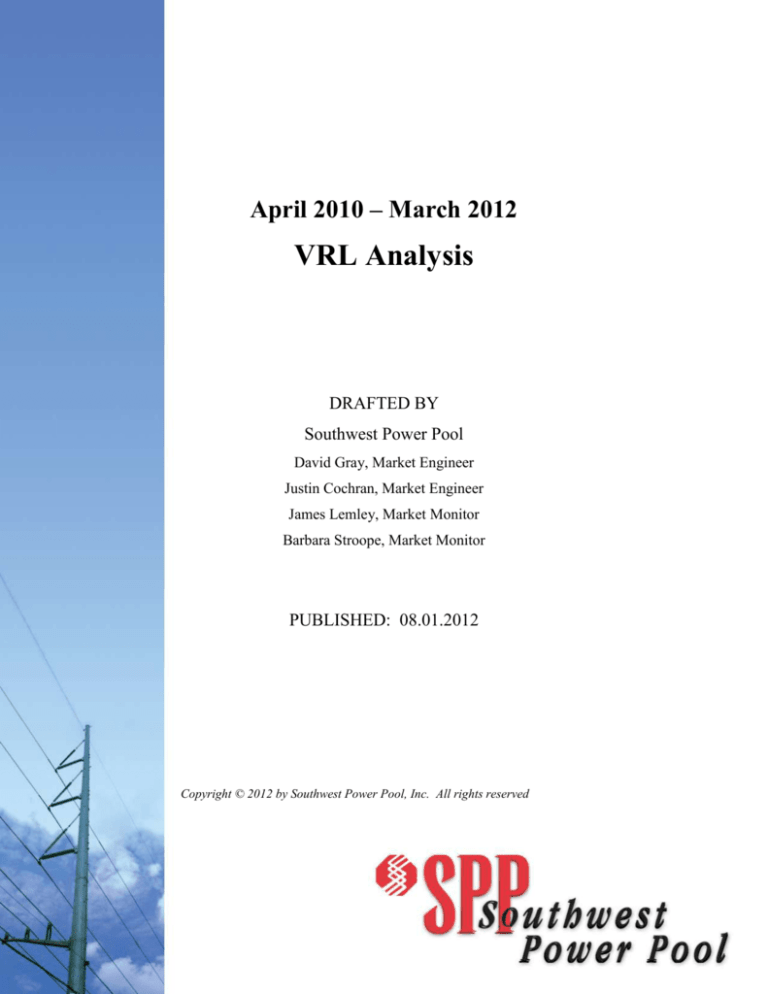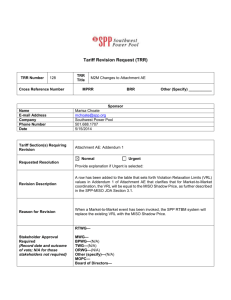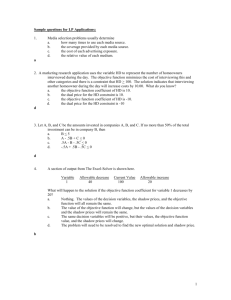
April 2010 – March 2012
VRL Analysis
DRAFTED BY
Southwest Power Pool
David Gray, Market Engineer
Justin Cochran, Market Engineer
James Lemley, Market Monitor
Barbara Stroope, Market Monitor
PUBLISHED: 08.01.2012
Copyright © 2012 by Southwest Power Pool, Inc. All rights reserved
Contents
Executive Summary .............................................................................................................................. 3
1. Background ...................................................................................................................................... 3
2. Analysis of OC Violations Characteristics in the Market ................................................................. 8
2011 VRL Analysis
Page 2 of 10
Executive Summary
The resource dispatch engine applied within the SPP EIS market includes Violation Relaxation
Limits (VRLs) to assist in quickly arriving at the best possible dispatch solution when it is infeasible
to simultaneously enforce all of the defined constraints. The categories of VRL include:
1) Operational constraint (OC)
2) Resource ramp rate limit
3) Generation-to-load balance
4) Resource maximum/minimum output
The resource maximum/minimum VRLs experienced no violation occurrences during the period of
April 2010-March 2012. The generation-to-load balance VRL experienced no violation occurrences
during the period of April 2010-March 2012. These hours were re-priced. The system-wide ramp
rate shortage VRL was applied a total of 356 times during the period. Instead of using the ramp VRL
value directly, all LIPs during up-ramp violations were set to the highest cleared offer and downramp violations were set to the lowest cleared offer.
The OC VRL most directly impacts the OC (flowgate) violations, and has been quantified from a
single block of $1,500 /MW to five blocks of $500/MW for 100% loading, $750/MW for 101%
loading, $1000/MW for 102% loading, $1250/MW for 103% loading, $1500/MW for 104%+
loading as of March 25, 2011. From April 2010 – March 2011, OC violations occurred for 5.07% of
all congested instances with an average shadow price of $1391.92. From April 2011 – March 2012,
OC violations occurred for 3.77 % of all congested instances with an average shadow price of
$788.60. For the purposes of this document, the term VRL will represent the Operating Constraint
(OC) VRL unless otherwise stated.
The data examined and analysis conducted by SPP of the use of block VRL results in the following
preliminary conclusions and recommendations:
The use of block VRL has resulted in a small decrease in violated instances, and at the
same time transmission usage has increased greatly and has reduced congestion cost and
pricing volatility.
SPP recommends keeping the current block VRLs of 100%, 101%, 102%, 103%, and
104% loading with the OC penalties of $500/MW, $750/MW, $1000/MW, $1250/MW,
and $1500/MW.
SPP will continue to monitor and analyze VRL occurrences, related market parameters
and circumstances going forward.
2011 VRL Analysis
Page 3 of 10
1. Background
The resource dispatch engine used by the SPP EIS market is named the Scheduling, Pricing
& Dispatching module, or “SPD”. It is a linear programming (LP) optimization algorithm that
includes an optimization equation and a series of constraint equations. The optimization equation for
the SPD engine is structured to minimize the total ‘cost’ of dispatching resources (based on offered
prices) to meet loads in the market net of scheduled interchanges. SPD has a companion module
named the Simultaneous Feasibility Test (SFT) engine which is a security-constrained economic
dispatch (SCED1). The LP constraint equations reflect the following categories of constraint for the
dispatch solution:
MW loading limit of each activated Operational Constraint (OC)
(flowgates and other transmission network branches)
MW per minute ramp rate limitation for each resource offering into the market as defined in
market participant resource plans;
Balancing of generation (resource) MW to load MW (including interchange) within the
market footprint;
Maximum and Minimum MW output levels for each resource as defined in market
participant resource plans.
The majority of LP optimization algorithms include some form of Violation Relaxation Limits
(VRLs2) to assist in quickly arriving at a ‘best possible’ solution when it is mathematically
impossible to strictly enforce every constraint. The algorithm will arrive at a final solution more
quickly if instructed that constraint violations translate to significant ‘indirect’ costs. This is true
even though the specific ‘$ per unit’ value assigned to VRLs generally is not specifically part of the
final dispatch solution. Rather, the VRL signals the dispatch solution engine to stop trying to find a
lower cost solution.
The SPD market simulation reflects a large-scale optimization. The conflict in constraint
requirements is resolved through relaxing calculation constraints in the VRL process. The levels at
which the VRLs are quantified signal to the LP algorithm a ‘comparable cost penalty’ for each
category of violation. This essentially provides a prioritization to the LP algorithm, since the
optimization then interprets that a MW of violation within one constraint category is ‘more costly’ or
‘less costly’ than violation of another constraint category.
________________________________
1
Various aspects of the SCED process applied within the EIS market dispatch are discussed within Section 4.1 of
Attachment AE to the SPP OATT. The SFT engine provides updated parameters to the SPD engine for each five-minute
EIS market interval.
2
VRL is specifically a term applied by SPP for the SPD engine of the EIS market; Operations Research
professionals will often refer to these parameters as the “cost of slack”, meaning the same as “cost of relaxation of the
limit”.
2011 VRL Analysis
Page 4 of 10
The four categories of VRLs applied in the Real-Time EIS Market are presently quantified as
summarized in Table 1 below:
Table 1: Categories of VRLs applied in the SPP Real-Time EIS Market
Violation Category
VRL $ level and unit of measure
Operational Constraint Limit
(i.e., flowgate or other network branch
$500 per MW of loading at 100% for each OC
loading)
$750 per MW of loading at 101% for each OC
$1000 per MW of loading at 102% for each OC
$1250 per MW of loading at 103% for each OC
$1500 per MW of loading at 104%+ for each OC
Resource Ramp Rate Limit
Generation – to – Load Balance
Resource Maximum/Minimum Limit
$5,000 per MW for each resource
$50,000 per MW in each deployment solution
$100,000 per MW for each resource
Quantifying the OC (flowgate) constraint VRL to exhibit the comparatively lowest $/MW magnitude
of the four categories, and the resource ramp rate limit VRL as next in magnitude, is largely based
on recognized and unavoidable trade-offs of the violation categories. While SPP pays great attention
to minimizing all the violations, short-term OC violations can be and are managed in coordination
with the transmission loading relief (TLR) procedures and other established operating procedures
implemented in coordination with Transmission Owners and other regional parties such as a
Congestion Management Event (CME). Altering the relative magnitude of the VRLs such that the
resource ramp rate limit VRL were to be the ‘lowest cost’ would result in significantly (and at times
dramatically) larger amounts of dispatch outside of defined ramp rate limits, which had been
discussed by the Market Working Group as an undesired trade-off. The same would be true of reordering the magnitude of the generation– – to– – load balance VRL or the resource
maximum/minimum MW limit VRL. It would result in undesired overall trade-off of the violations
experienced.
Thus, all else being equal, the LP dispatch engine will inherently interpret that:
A MW of OC violation presents a lower indirect penalty than a MW of resource ramp rate
violation
A MW of ramp rate violation presents a lower indirect penalty than a MW violation of
market generation to market load balance
A MW of generation to load balance violation reflects a lower indirect penalty than a MW
violation of resource max to min limit.
To further understand the VRL parameter, it is useful to address the concept of the operational
constraint shadow price. The OC Shadow Price is effectively the marginal cost of a re-dispatch in
the market impacting an operating constraint that has reached its MW loading limit (expressed as $
per MW of loading). The equation immediately below reflects a generalized formulation of the OC
Shadow Price when a single operational constraint has reached its limit within the dispatch solution.
2011 VRL Analysis
Page 5 of 10
Because the shadow price is affected by the inverse of the marginal impact of re-dispatch on
constraint loading (i.e., the shift factors are in the divisor of this equation), the OC Shadow Price can
reach a relatively high level before the offer prices are of a similar magnitude.
Shadow Price C = (OP MR1 – OP MR2) / (Shift Factor C, MR1 - Shift Factor C, MR2)
Where,
MR = Marginal resource
OP = Offer price
OP MRX = Marginal offer price of marginal resource X, and
Shift Factor C, MRX = Shift factor for marginal resource X applying to C (shadow price)
As an example of the above formulation, let us assume that one of two marginal resources has a shift
factor of +0.01 and the other marginal resource has a shift factor of -0.01. This means that a redispatch in which one of the resources increases output by 50 MW and the other resource decreases
output by 50 MW would impact loading on the constraint by 1 MW.3 If the difference of the offer
prices for these two marginal resources (OPMR1 – OPMR2) is $20 per MWh, the net cost impact (C) of
re-dispatching these resources expressed per MW of OC loading impact is $20 / 0.02 = $1,000 per
MW per hour. (= the OC Shadow Price if that OC is binding within the dispatch solution).
It is useful to note that because the locational price solutions are based on the marginal resources
dispatched, the details of the OC VRL are applied somewhat differently within the locational price
solution than the other three VRL categories, as summarized below:
The OC VRL effectively places a cap on the marginal cost of a market dispatch impacting
the OC loading, and may also be characterized as a cap on the shadow price of the constraint.
Thus, a larger OC VRL effectively instructs the SPD dispatch engine to seek higher-cost redispatches to remove loading violations from the dispatch solution, typically resulting in
lower levels of flowgate overload. If a constraint continues to exceed its loading limit within
the dispatch solution, a marginal re-dispatch cost higher (perhaps dramatically higher) than
the assumed VRL would be necessary to elicit additional relief and the solution allows the
limit to be temporarily exceeded, rather than calculating a higher cost dispatch.
For the other constraint types (ramp rate limit, generation-to-load balance, and resource
max/min limits), the level of penalty or ‘slack’ reflected in the dispatch solution is ‘frozen’
for purposes of the marginal computations, , which effectively removes these VRL ‘violation
costs’ from the final LIP computations by effectively pricing based upon the marginal
resources dispatched.4
Thus, establishing the $$ /MW value of the OC VRL involves an inherent trade-off between the
frequency and MW levels of violations experienced and the magnitudes of price separation
experienced.
__________________________________________________________________________
3
(50 MW * 0.01) – (50 MW * - 0.01) = 1 MW of Δ in constraint loading
This mechanism provides a further perspective on why the specific values used for these three categories of VRLs are
not directly relevant to the final price solution
4
2011 VRL Analysis
Page 6 of 10
The Locational Imbalance Price (LIP) is the price administered to the resource. The System Marginal
Price “SMP” is the average reference price for the system calculated directly within the dispatch
engine. The Shift factor is the reflect impact of delivering generation to the loading constraint k
relative to the delivery of the reference in a sum weighted average. Shadow Price represents the
marginal cost impact on incrementally loading a constraint.
LIPi SMP k [Shift Factori,k Shadow Price k ]
LIP= Locational Imbalance Price
SMP = System Marginal Price
I = Resource
K= Constraint
The shadow price component affects the resources Location Imbalance Pricing (LIP) only during
congestion. When congestion occurs it gives the flowgate a negative Shadow Price and signals the
dispatch engine to increase or decrease generation on the constraint tangent upon what’s the resource
shift factor to the relative constraint.
2011 VRL Analysis
Page 7 of 10
2. Analysis of OC Violation Characteristics in the Market
Due to the changing of OC VRL values in March 2011 to the block VRLs from the single $1500
value, the data has been separated between April 2010 through March 2011 and April 2011 through
March 2012. Figure 1 and 2 shows the total OC Constraint Violation Instances by the percentage the
OC was beyond the OC in an increasing percent format below the graph. A violation is any time the
flowgate loading is above the flowgate limit within the dispatch solution. There are a total of 11,608
flowgate violation instances from April 2010 through March 2012. For April 2010 through March
2011 ($1500 single VRL), there were a total of 5,990 violation instances representing 5.07% of all
congested instances. The average shadow price of the violated instances for this time range was
$1391.92 and an average violation of 5.27%. For April 2011 through March 2012 (block VRL), there
were a total of 5,618 violation instances representing 3.77% of all congested instances. The average
shadow price of the violation instances for this time range was $788.60 and an average violation of
3.12%. Figures 1 and 2 show the number and percent of OC violates by percent category for the two
time frames studied.
FIGURE 1 – 5,990 Total OC Violation Instances – Single $1500 VRL
2011 VRL Analysis
Page 8 of 10
FIGURE 2 – 5,618 Total OC Violation Instances – Block VRL
Figure 3 and 4 shows the distribution of 255,539 Shadow Prices instances for Binding intervals from
April 2010 through March 2012. Binding intervals are defined as 5-minute intervals where the flow
across the flowgate exactly equals the limit of the flowgate. Price separation occurs and is reported
because the algorithm is looking for the next lowest cost segment of the next available unit. The cost
associated with the displacement of the initial marginal unit is the incremental cost to calculate a
penalty free LIP. For April 2010 through March 2011 ($1500 single VRL), there were a total of
112,062 binding instances with an average shadow price of $98.57. For April 2011 through March
2012 (block VRL), there were a total of 143,477 binding instances with an average shadow price of
$62.57. Figure 3 illustrates that 97.27 percent of all binding instances had a shadow price below
$500/MW. Shadow prices between $500/MW and $1,000/MW accounted for 2.06 percent. While only
0.67 percent of all binding instances occurred above $1,000/MW. Figure 3 shows that shadow price
instances over $500/MW (2,277 or 2.73% of total binding instances) additional intervals might have
violated if the OC were changed to VRL Block format with a tradeoff of lowering the shadow price
for these binding instances. Fig Figure 4 illustrates that 97.77 percent of all binding instances had a
shadow price below $300/MW. Shadow prices between $300/MW and $400/MW accounted for
1.56% percent. While only 0.67 percent of all binding instances occurred above $400/MW.
2011 VRL Analysis
Page 9 of 10
FIGURE 3 – 112,062 TOTAL BINDING INSTANCES – Single $1500 VRL
$1000-$1500 SP
0.67%
$500-$1000 SP
2.06%
$0-$500 SP
97.27%
FIGURE 4 – 143,477 TOTAL BINDING INSTANCES – Block VRL
$400+ SP
0.67%
$300-$400 SP
1.56%
$200-$300 SP
5.09%
$100-$200 SP
14.32%
2011 VRL Analysis
$0-$100 SP
78.36%
Page 10 of 10








